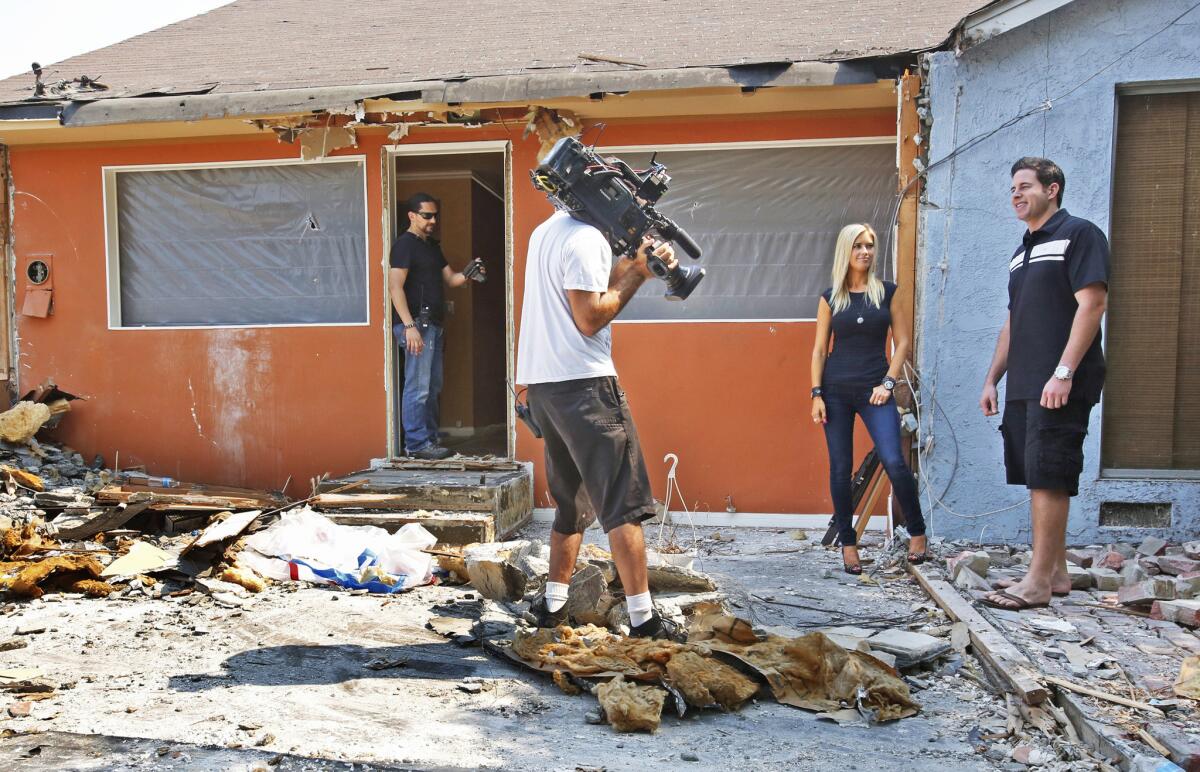HGTV builds into a top cable network on foundation of no-frills shows

As hard as it may be to imagine, there was a time not so long ago when few Americans had ever heard the expression “man cave.”
In 1994, PBS’ trusty “This Old House” was the best known of a handful of home-improvement programs on the airwaves. The idea of HGTV, a 24-hour lifestyle network devoted to gardening, decorating, crafting and do-it-yourself renovations that launched that year, seemed ridiculously narrow, prompting the New York Times to wonder, “Is America ready for all-home TV?”
Now as HGTV closes in on its 20th anniversary, the question seems almost quaint: Once derided as “compost TV,” it has become a top-10 cable network in prime time available in 96 million homes and part of a multimedia lifestyle brand that includes a magazine and website. Its ratings grew in tandem with the real estate market boom of the early aughts, arguably helping fuel the nation’s lust for granite countertops and open-concept kitchens, and were only briefly dampened by the subprime mortgage crisis and Great Recession.
And while other networks have seen breakout real estate hits such as “Trading Spaces” and “Extreme Makeover: Home Edition” quickly wear out their welcome with viewers, HGTV has built a lineup full of quiet, consistent performers — most notably, the 15-year-old “House Hunters” franchise. The network’s pleasantly formulaic programming, which includes “Property Brothers,” “Flip or Flop” and “Fixer Upper,” offers ever-so-slight variations on the same theme: people buying, renovating and selling property.
This reliability has made HGTV a favorite go-to destination for affluent, educated viewers, particularly women, unable to resist taking a voyeuristic glimpse into other people’s domestic lives and engage in a bit of risk-free real estate speculation. Case in point: When Hillary Rodham Clinton was preparing to step down as secretary of State in 2012, she said she hoped to spend more time watching “Love It or List It.” (“I find it very calming,” she told the New York Times.)
In the process, the Knoxville, Tenn.-based network has also become a pop cultural touchstone, with its flagship series “House Hunters” inspiring drinking games, a “Jeopardy” question and jokes on “30 Rock” and “Saturday Night Live.”
As Kathleen Finch, president of Scripps Networks Interactive Home Category, which includes HGTV and its sister channel DIY, puts it, “I think we’re the guilty pleasure of a lot of intelligent people.”
The network relies heavily on shows featuring duos of “real people” — as opposed to trained TV hosts — who are knowledgeable in real estate and also happen to look good on camera. The so-called Property Brothers, identical Canadian twins Drew and Jonathan Scott, have three shows with a fourth on the way and have become the de facto faces of HGTV as well as heartthrobs. (They made People magazine’s “Sexiest Men Alive” list last year.) There’s also Tarek and Christina El Moussa, the telegenic SoCal married couple featured in “Flip or Flop,” and Chip and Joanna Gaines, the equally eye-pleasing husband-and-wife team on “Fixer Upper.”
For many fans, the relationships are at least as intriguing as the real estate. As humorist and “Daily Show” contributor John Hodgman recently tweeted, “Every ‘House Hunters International’ could be subtitled ‘What Are They Running From’ or ‘When Will They Divorce?’”
At some level, HGTV’s appeal may have as much to do with its own pleasantly escapist offerings as with what’s available elsewhere on the dial. Compared with the perpetually gloomy and increasingly partisan 24/7 news cycle and the dark, complicated storytelling associated with the current “Golden Age of TV,” HGTV acts as a bit of much-needed counterprogramming, said Shawn Shimpach, an associate professor of film studies at the University of Massachusetts Amherst.
“‘Pick one of three homes and have a happy ending’ might be just what you need at the end of a hard day,” Shimpach said.
‘Useful escapism’
The network launched in December 1994 as a TV equivalent of niche lifestyle magazines like Better Homes and Gardens. It was initially a tough sell with cable operators, who questioned whether the public would be interested in watching 24 hours of “paint drying and grass growing,” as an HGTV executive joked at the time. But HGTV spread like kudzu, reaching 57 million homes by 1999 and turning a profit after just three years.
Viewers, it seemed, couldn’t resist what then-Vice President Burton Jablin described as the network’s “useful escapism.” By the turn of the millennium, anecdotal evidence of HGTV’s addictive qualities was widespread. (“My drug is the ultimate guilty pleasure, the narcotic I’m powerless to resist. Home & Garden Television,” wrote Times critic Howard Rosenberg in 2000.)
In its first decade on the air, one could tune in to HGTV any hour of the day for tips on transplanting rosebushes or sprucing up a tired love seat with an eye-catching slipcover, but personality-driven real estate and renovation programming gradually began to edge out shows about decorating and gardening.
“As the Internet has taken over as the place to get that how-to information, that’s enabled us to put entertainment at the top of our list and to make shows about terrific talent, situations that might be more voyeuristic and fun,” said Finch, a former television news producer.
The launch of “House Hunters” in 1999 marked a pivotal moment in the network’s evolution. The show was conceived by Tara Sandler and Jennifer Davidson, founders of the production company Pie Town, who’d discovered a niche in the early days of reality television with such low-budget documentary series as “A Baby Story” and “A Dating Story” for TLC. The pair, also life partners, were inspired by their own stressful experience buying a home.
The “House Hunters” premise is so simple it’s hard to believe no one had thought of it sooner: Potential home buyers (and occasionally renters) tour three properties, ultimately choosing one based on criteria that is often wildly unrealistic and/or maddeningly specific. (Davidson is still baffled by the architect who refused to buy a home with hallways because he considered them “a waste of space.”)
In 2006, “House Hunters International” was added to HGTV’s lineup and quickly became as popular as the original, spawning yet more spinoffs: “House Hunters Renovation,” “House Hunters on Vacation” and “House Hunters: Where Are They Now?”
Aside from a few tweaks, including adding the price of the homes for sale, the show’s basic structure has not changed dramatically. But over the years producers have shifted to emphasize big characters, not just big homes. “The personalities and the really interesting psychology are, in my opinion, what’s driving the show more these days than simply looking inside,” said Davidson, whose North Hollywood-based company will deliver 170 episodes of “House Hunters” this year along with other shows including “Flip or Flop.”
Some 2,000 episodes of “House Hunters” and its various incarnations have been made by Pie Town and other independent production companies using a bare-bones crew and a budget that is “on the lower side,” according to Sandler and Davidson. “Our real sweet spot is finding a hit series and making lots and lots of episodes, and there’s some economies of scale that come with that,” said HGTV General Manager Allison Page.
“Every second a baby is born and a ‘House Hunters’ episode is produced,” said Finch, who calls the series, which airs every weeknight at 10 and averages 1.6 million viewers, “the evening news of HGTV.”
Inflating the bubble
As HGTV moved more aggressively into shelter TV — and property values escalated wildly across the country — other networks followed suit with their own aspirational reality series.
“Flip That House” on TLC, “Flip This House” on A&E and “Flipping Out” on Bravo played up the idea that with a fresh coat of paint and some stainless steel appliances, practically any home could be resold for a profit. Meanwhile, the massive ABC hit “Extreme Makeover: Home Edition” turned home improvement into tear-jerker TV. (Never mind that some of the families featured on the show actually went into foreclosure as a result of the show’s elaborate and expensive renovations.)
Imitation may be the sincerest form of flattery, but HGTV found itself an easy target for criticism after the subprime mortgage meltdown and global economic downturn in 2008. An opinion piece in the Wall Street Journal in 2009 denounced the network as “an evil empire that never rests.” “You couldn’t watch these shows without concluding that you must be an idiot and a loser if you lived in a house you could actually afford,” it charged.
Although such claims might be hyperbolic, others agree that the network helped inflate the housing bubble. “HGTV was not blameless,” said Anna Everett, a professor of film and media studies at UC Santa Barbara. “There is an aspirational element to the network that fed into the crash.”
Sensitive to the public’s shifting mood, the network made some adjustments to its lineup in 2009, adding frugally minded programs like “Real Estate Intervention” and “Income Property” while doubling production on “House Hunters International,” with its implicit promise of escape. Ultimately, ratings were only briefly affected by the real estate crash.
HGTV found itself at the center of a less dire controversy in 2012 when an Ohio-based blogger named Julia Sweeten posted an item on her website, Hooked on Houses, recounting the experiences of a reader who had appeared on “House Hunters.” The story revealed the not terribly shocking fact that the show’s would-be buyers have usually decided on their home before the cameras start rolling. Fans responded like kindergartners discovering the truth about Santa Claus.
“For a long time I got lots of hate mail from people who said I ‘ruined’ their favorite show for them,” Sweeten said, though she — and many millions of others — continue to watch the various iterations of “House Hunters,” well aware it’s not exactly cinéma vérité.
Creating a comfort zone
If anything, the tidy, unwavering formula of HGTV’s programming may be one of its greatest selling points.
“All home improvement shows do is make things better,” said Lindy West, a writer for Jezebel.com and an avid HGTV watcher. “They take old, dated, poorly planned, inconvenient, ugly spaces and they make them better. It’s so satisfying.”
She also notes that the channel’s consistency makes it perfect for marathon viewing. Indeed, the schedule is tailor-made for binge-watching, with programs airing in blocks of three or four episodes in a row throughout the day and leading seamlessly into similarly themed programs. The strategy works: According to Nielsen, in June the typical weekend tune-in to HGTV was 25% longer than the cable average.
HGTV is also the biggest revenue engine for parent company Scripps Networks Interactive, which also owns the majority of the Food Network (along with the Tribune Co., parent of The Times), last year generating nearly $880 million in revenue. The channel provides more than a third of the company’s $2.45 billion operating revenue and has shown significant growth, with its 2013 revenue increasing 11.8% compared with the previous year.
According to a recent analysis by the investment research firm Morningstar, HGTV’s programming speaks to viewers “with significant disposable income,” making it enticing to advertisers, but faces the threat of encroachment from more broad-based cable networks interested in capitalizing on this lucrative niche.
Unlike other cable channels that rely on a few breakout hits, HGTV has built a lineup of shows with solid if not “Duck Dynasty”-spectacular ratings, with its most-watched series reliably garnering between 1 million and 2 million viewers in prime time.
“We’re not looking to produce hit shows so much as we’re looking to create a consistent, night-by-night ratings juggernaut,” said Finch. “We don’t invite viewers to a single show, we invite them to the network, and so when they come, they stay.”
Apparently there are many women just like Clinton, “Lean In” types who like to unwind by watching hour after hour of real estate television. The network ranks No. 1 on cable among women with incomes of $100,000 and higher and performs especially well on the weekends. For the second quarter of 2014, 73% of HGTV’s prime-time audience was female, 78% were homeowners and 67% had attended college.
Even, or perhaps especially, in an era when binge-watching is an activity associated with such challenging fare as “Breaking Bad,” HGTV’s easily digested programming has a distinct appeal. Competing cable networks continue with their own property series — Bravo has its flashy and ever-expanding “Million Dollar Listing” franchise, full of brash personalities and over-the-top properties, while the carnivalesque TLC recently launched “Buying Naked,” about house-hunting nudists.
Compared with these shows, HGTV’s programming is tame, soothing — even polite. (This effect is heightened by the conspicuous number of Canadian accents heard on several shows produced north of the border.)
HGTV also continues to find still more ways to recycle the inexpensive “House Hunters” formula with shows such as “Living Alaska,” “Beachfront Bargain Hunt” and “Island Hunters” featuring property quests in exotic locales.
“We call it ‘property porn,’” said Drew Scott of “Property Brothers.” “That’s what people want to see. They’ll never get sick of it.”
Twitter: @MeredithBlake
More to Read
The complete guide to home viewing
Get Screen Gab for everything about the TV shows and streaming movies everyone’s talking about.
You may occasionally receive promotional content from the Los Angeles Times.






